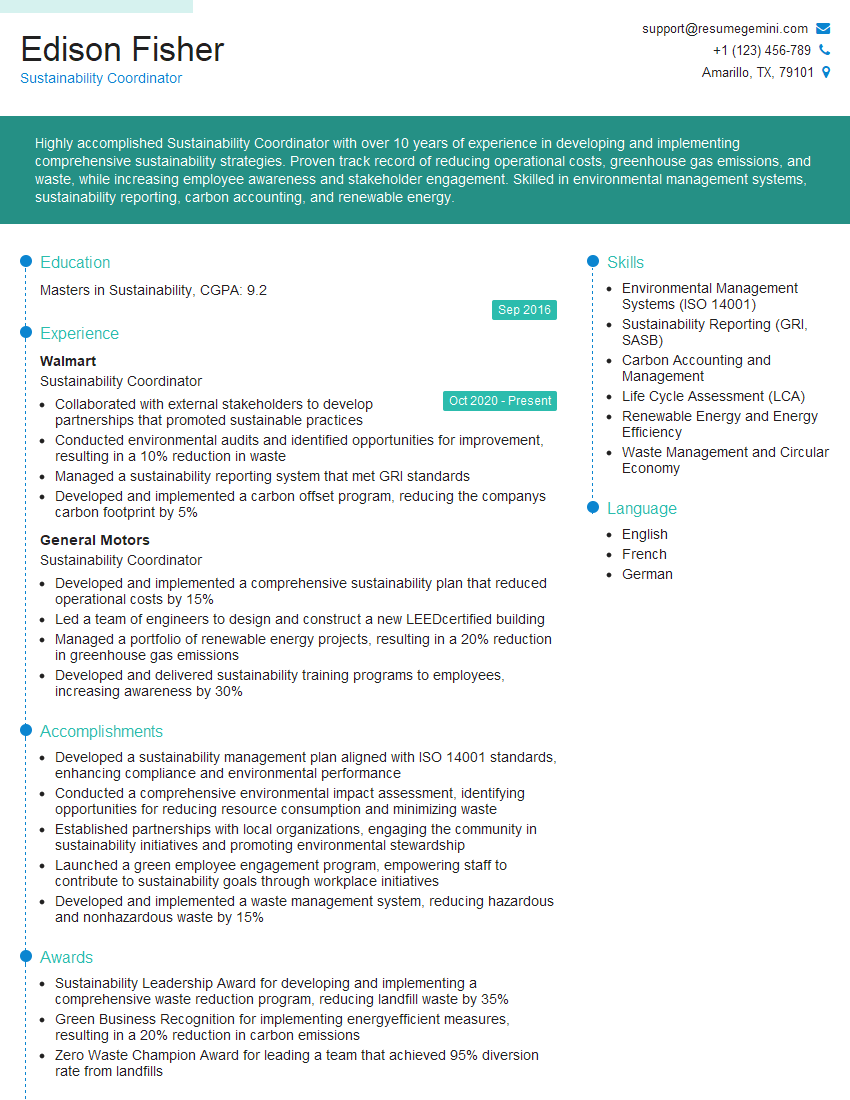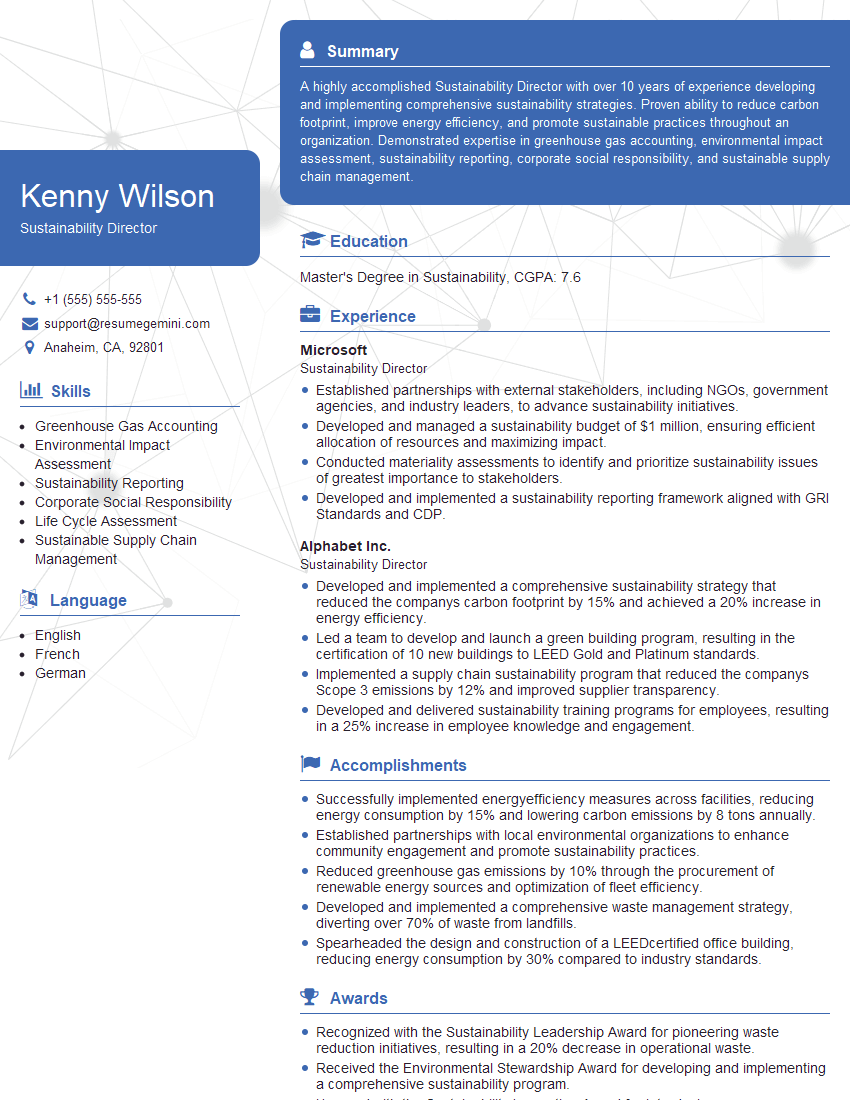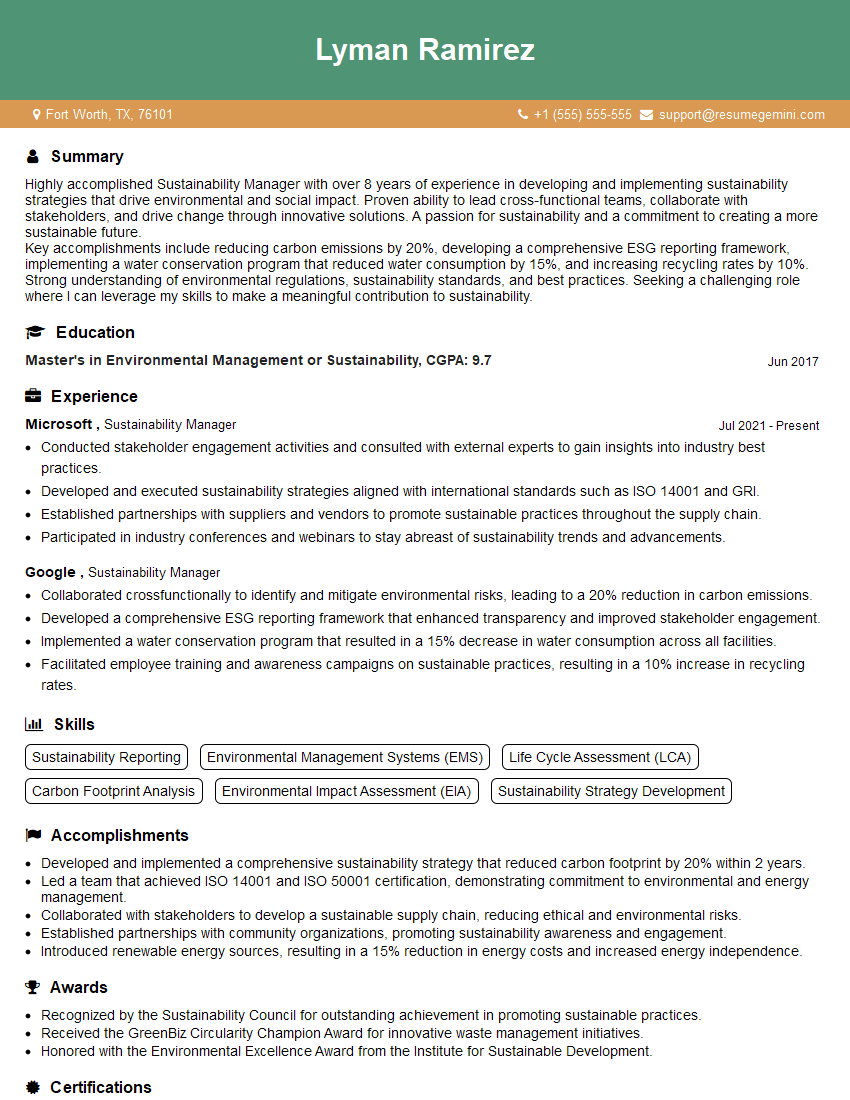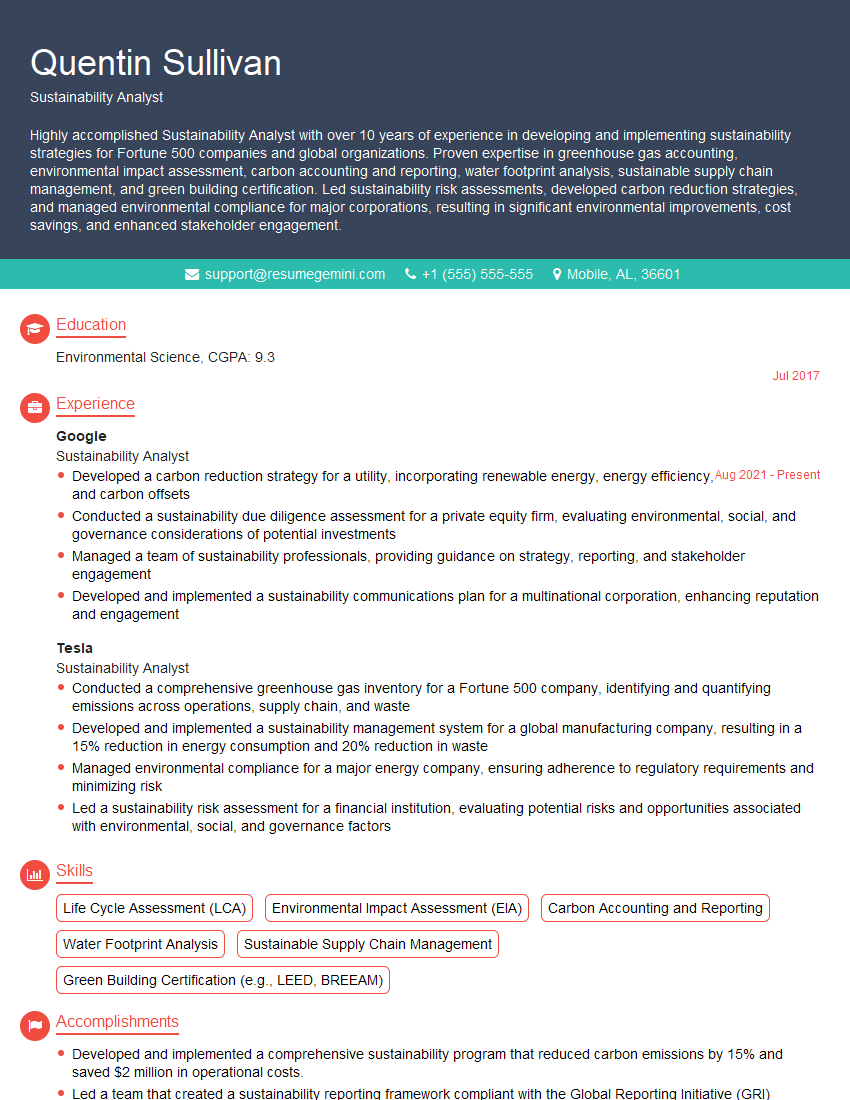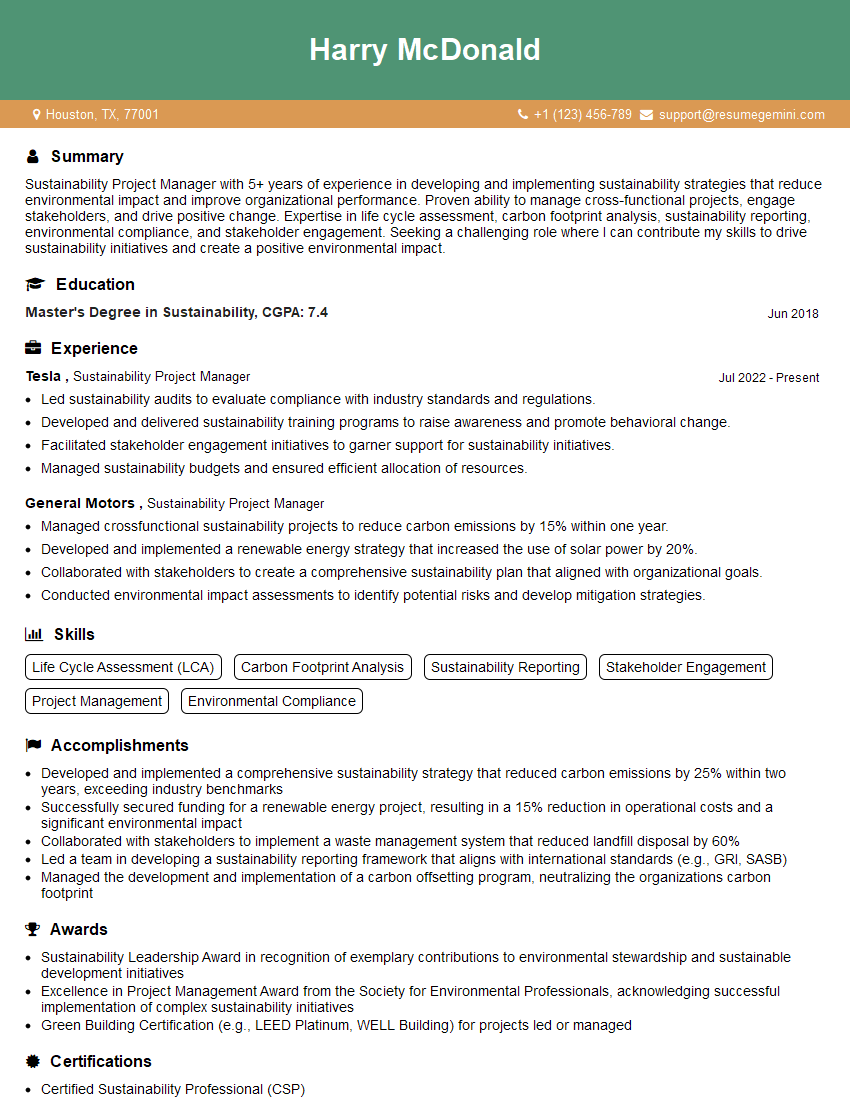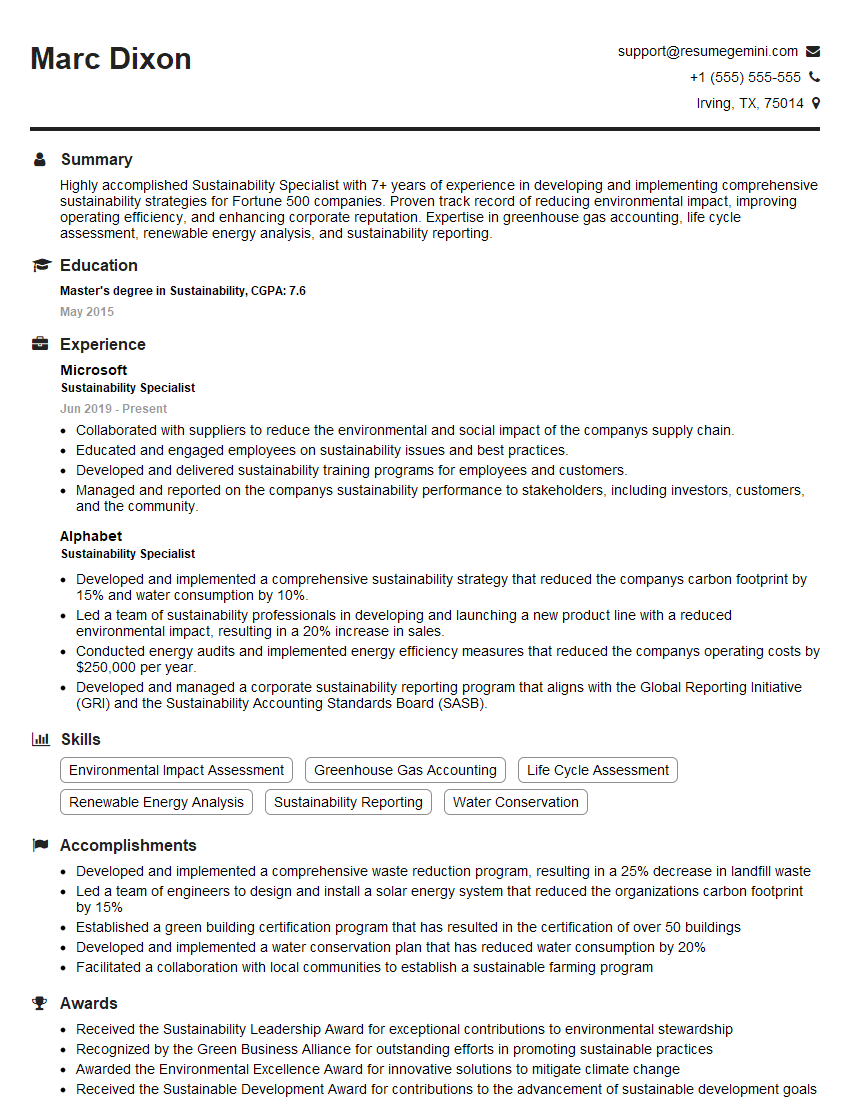Unlock your full potential by mastering the most common Sustainable Business Development interview questions. This blog offers a deep dive into the critical topics, ensuring you’re not only prepared to answer but to excel. With these insights, you’ll approach your interview with clarity and confidence.
Questions Asked in Sustainable Business Development Interview
Q 1. Define ‘materiality’ in the context of ESG reporting.
In ESG (Environmental, Social, and Governance) reporting, materiality refers to the significance of ESG factors to a company’s business, strategy, and financial performance. It identifies the ESG issues that are most important to stakeholders and have the potential to materially impact the organization’s value creation. Think of it as determining what truly matters – which ESG aspects significantly affect your business and its success, both positively and negatively. It’s not just about ticking boxes; it’s about focusing on what truly drives or threatens your company’s long-term viability.
For example, a fashion company might find that materiality assessment reveals that water consumption in textile production and ethical sourcing are incredibly material to their business, while perhaps carbon emissions from transportation are less impactful compared to their industry peers. This allows them to focus their resources and reporting efforts efficiently.
A robust materiality assessment involves engaging with stakeholders (investors, employees, customers, communities) to identify their key concerns and mapping these to the company’s operations and value chain. The outcome is a prioritized list of material ESG issues that informs the company’s strategy and reporting.
Q 2. Explain the difference between Scope 1, Scope 2, and Scope 3 greenhouse gas emissions.
Greenhouse gas (GHG) emissions are categorized into three scopes to clarify their origin and facilitate effective management:
- Scope 1: Direct emissions – These are emissions produced directly by a company’s operations. This includes emissions from owned or controlled sources, such as company vehicles, stationary combustion (e.g., boilers), and fugitive emissions (e.g., leaks from refrigerants). Think of it as the emissions you directly create.
- Scope 2: Indirect emissions from energy consumption – These emissions are generated from the production of purchased energy consumed by the company. For instance, the emissions from the power plant that supplies electricity to your office building are Scope 2 emissions. It’s the emissions from the energy you buy to power your operations.
- Scope 3: Other indirect emissions – This is the broadest category, encompassing all other indirect emissions that occur in a company’s value chain, but are outside its direct control. Examples include emissions from purchased goods and services (e.g., materials, supplies), transportation and distribution of products, business travel, waste generated in operations, and the use of sold products.
Imagine a coffee company: Scope 1 would be emissions from their roasting facilities; Scope 2 would be from electricity used in the roastery and offices; and Scope 3 would include emissions from coffee bean farming, transportation of beans and roasted coffee, disposal of coffee grounds by consumers, and even emissions from the use of disposable coffee cups.
Q 3. Describe your experience with Life Cycle Assessment (LCA).
I have extensive experience conducting and interpreting Life Cycle Assessments (LCAs). LCAs are powerful tools that quantify the environmental impacts of a product, service, or process across its entire life cycle, from raw material extraction to end-of-life disposal. This cradle-to-grave approach allows for a comprehensive understanding of the environmental footprint.
In my previous role, I led an LCA for a packaging company to evaluate the environmental impacts of different packaging materials (plastic, paper, and compostable alternatives). The LCA considered various factors including resource depletion, greenhouse gas emissions, water consumption, and waste generation at each stage of the life cycle. The results were crucial in informing the company’s decision to switch to more sustainable packaging options, significantly reducing their environmental impact. The process involved data gathering, impact assessment using recognized methodologies like ISO 14040/44, interpretation of results and recommendation of sustainable solutions.
LCAs are not merely academic exercises. They provide actionable insights to drive meaningful improvements in sustainability performance. They are vital for businesses to understand their true environmental impact and make informed, data-driven decisions.
Q 4. How would you measure the success of a sustainability initiative?
Measuring the success of a sustainability initiative requires a multi-faceted approach that goes beyond simple metrics. It’s crucial to define clear, measurable, achievable, relevant, and time-bound (SMART) goals upfront. Success should be measured against these predefined goals using both quantitative and qualitative indicators.
Quantitative indicators might include reductions in GHG emissions (tons of CO2e), water consumption (liters), waste generation (kg), or energy use (kWh). Qualitative indicators might involve improvements in employee engagement, customer satisfaction related to sustainability, and stakeholder perception of the company’s sustainability performance.
For instance, a successful waste reduction initiative might be measured by tracking the percentage reduction in waste sent to landfills, the increase in recycling rates, and employee feedback on the effectiveness of the implemented programs. It’s important to track progress regularly, adapt the strategy as needed and to communicate findings transparently.
Q 5. What are the key elements of a robust sustainability strategy?
A robust sustainability strategy needs several key elements to ensure effectiveness:
- Clear Vision and Goals: A well-defined vision that articulates the company’s long-term sustainability aspirations and specific, measurable, achievable, relevant, and time-bound (SMART) goals.
- Materiality Assessment: Identifying the most significant ESG issues relevant to the business and its stakeholders.
- Stakeholder Engagement: Actively involving stakeholders (employees, customers, investors, communities) in the sustainability process.
- Integration into Business Strategy: Embedding sustainability considerations into core business functions and decision-making processes.
- Data Collection and Monitoring: Establishing robust systems for collecting and monitoring key sustainability performance indicators.
- Reporting and Transparency: Regularly reporting on sustainability progress and performance in a transparent and credible manner.
- Resource Allocation: Committing sufficient resources (financial, human, and technological) to support the implementation of the sustainability strategy.
- Continuous Improvement: Regularly reviewing and updating the sustainability strategy based on performance data, stakeholder feedback, and emerging best practices.
Without a holistic and integrated approach, sustainability efforts can easily become isolated projects rather than a core aspect of the business’s strategic direction.
Q 6. Explain your understanding of the circular economy principles.
The circular economy is a model that aims to minimize waste and maximize the value of resources by keeping materials in use for as long as possible. It moves away from a linear “take-make-dispose” model to a cyclical one where resources are recovered, repurposed, and reused. Think of it like a closed loop rather than a one-way street.
Key principles of the circular economy include:
- Design out waste and pollution: Developing products and processes that minimize waste and pollution from the outset.
- Keep products and materials in use: Extending the lifespan of products through repair, reuse, and remanufacturing.
- Regenerate natural systems: Restoring and enhancing natural ecosystems and biodiversity.
A practical example is a company that designs its products for easy disassembly and component reuse or recycling. This extends product life and avoids the creation of waste. Another example would be a clothing company implementing a clothing take-back program to recover and recycle old clothes instead of them ending up in landfills.
Q 7. Describe your experience with stakeholder engagement in sustainability projects.
Stakeholder engagement is paramount in successful sustainability projects. It’s not just about informing stakeholders; it’s about building partnerships and collaboratively shaping solutions. My experience spans various engagement methods, from surveys and focus groups to workshops and multi-stakeholder dialogues.
In a project involving community engagement for a renewable energy initiative, we organized several public forums to address local community concerns about the project’s impact on the environment and local infrastructure. We proactively sought their input to adapt our plans, minimizing disruption and maximizing community benefits. This participatory approach led to stronger community support and a more successful project implementation.
Effective stakeholder engagement requires careful planning, thoughtful communication, and genuine consideration of diverse perspectives. It is crucial to create transparency, actively solicit feedback, and demonstrate a commitment to addressing stakeholder concerns.
Q 8. How familiar are you with GRI Standards or SASB Standards?
I’m very familiar with both the Global Reporting Initiative (GRI) Standards and the Sustainability Accounting Standards Board (SASB) Standards. These are crucial frameworks for sustainability reporting, providing a common language and structure for businesses to communicate their environmental, social, and governance (ESG) performance.
GRI Standards offer a comprehensive set of guidelines covering a wide range of ESG issues, allowing businesses to report on their impacts across various aspects of their operations. They are widely adopted and recognized globally, promoting transparency and comparability across different organizations.
SASB Standards, on the other hand, are more focused on material ESG issues that are financially material to specific industries. They aim to help companies identify and disclose the sustainability information most relevant to investors’ decisions. This industry-specific focus makes SASB particularly valuable for assessing financial risk and opportunity associated with ESG performance.
My experience includes using both standards to guide reporting processes, analyze sustainability data, and support companies in improving their ESG profiles. I understand the nuances of both frameworks and can effectively leverage them for different reporting needs.
Q 9. How would you address resistance to sustainability initiatives from within an organization?
Addressing resistance to sustainability initiatives requires a multi-pronged approach, focusing on communication, education, and demonstrating value. Simply mandating change often leads to resentment and passive resistance.
- Education and Communication: Start by clearly communicating the why behind the initiatives. Highlight the business benefits of sustainability, such as cost savings, enhanced brand reputation, and access to new markets. Use data and case studies to illustrate the positive impacts of sustainable practices. Address concerns and misconceptions directly and honestly.
- Demonstrate Value: Show tangible results early on. Start with smaller, achievable goals that demonstrate quick wins and build momentum. Track and report on progress regularly, showcasing the positive impact of implemented initiatives.
- Engage and Involve: Include employees at all levels in the process. Seek input, ideas, and feedback. Create a sense of ownership and shared responsibility. Consider forming a cross-functional sustainability team to foster collaboration.
- Leadership Support: Secure buy-in from top management. If leadership is not committed, sustainability initiatives will struggle to gain traction. Their visible support and championing of these initiatives are crucial.
- Incentivize and Reward: Reward individuals and teams who actively contribute to sustainability goals. This might include bonuses, recognition programs, or other incentives that align behavior with sustainability objectives.
For example, in one project, we initially faced resistance to reducing water consumption in a manufacturing plant. By showcasing the significant cost savings from reduced water bills and improved efficiency, we were able to overcome the initial skepticism and build a culture of water conservation.
Q 10. What are some common barriers to implementing sustainable practices in a business?
Implementing sustainable practices often faces numerous barriers. These can be broadly categorized as financial, operational, and knowledge-related.
- Financial Barriers: Upfront investments in sustainable technologies or processes can be significant, and the return on investment (ROI) may not be immediately apparent. This is particularly challenging for small and medium-sized enterprises (SMEs) with limited financial resources.
- Operational Barriers: Integrating sustainable practices can disrupt existing workflows and require significant changes in operational processes. This can lead to disruptions, inefficiencies, and resistance from employees accustomed to traditional methods.
- Knowledge and Skill Gaps: A lack of awareness, knowledge, and expertise in sustainable practices can hinder implementation. Businesses may lack the necessary skills to assess environmental impacts, develop sustainability strategies, and implement effective solutions.
- Lack of Measurement and Accountability: Without proper systems for measuring and tracking progress, it’s difficult to assess the effectiveness of sustainability initiatives and hold individuals accountable. This often leads to a lack of focus and follow-through.
- Regulatory Uncertainty: Changes in regulations and policies can impact the feasibility and cost of implementing sustainable practices. Uncertainty about future regulations can lead to hesitation and delay in making necessary investments.
Overcoming these barriers requires a well-defined strategy, careful planning, access to relevant information and training, and strong leadership commitment.
Q 11. How can businesses integrate sustainability into their supply chain?
Integrating sustainability into the supply chain requires a collaborative approach, focusing on transparency, engagement with suppliers, and continuous improvement.
- Supplier Engagement: Collaborate closely with suppliers to assess their environmental and social performance. This may involve conducting supplier audits, setting sustainability targets, and providing technical assistance to improve their practices. Consider using sustainability rating tools to assess and rank your suppliers.
- Transparency and Traceability: Establish robust traceability systems to track materials and products throughout the supply chain. This improves visibility into environmental and social impacts, facilitating responsible sourcing.
- Sustainable Sourcing: Prioritize suppliers who demonstrate strong sustainability commitments and practices. Source materials from certified sustainable sources whenever possible (e.g., FSC-certified wood, Fairtrade-certified coffee).
- Collaboration and Partnerships: Foster collaborative relationships with suppliers to share best practices and develop joint sustainability initiatives. This includes jointly setting sustainability targets, and sharing resources and expertise.
- Incentives and Rewards: Reward suppliers who meet or exceed sustainability targets. This can include preferential purchasing terms, longer-term contracts, or other incentives that encourage better performance.
For example, a clothing company might collaborate with its cotton suppliers to implement water-efficient irrigation techniques, reducing water consumption and promoting more sustainable cotton farming practices.
Q 12. Explain the concept of sustainable procurement.
Sustainable procurement focuses on integrating environmental, social, and economic considerations into the entire purchasing process, from planning to disposal. It’s about buying goods and services that are environmentally responsible, socially equitable, and economically viable, minimizing negative impacts and maximizing positive ones.
Key aspects include:
- Environmental Criteria: Considering factors such as carbon footprint, energy efficiency, recyclability, and the use of sustainable materials.
- Social Criteria: Assessing labor practices, fair wages, working conditions, and community impacts of the supplier.
- Economic Criteria: Evaluating long-term cost-effectiveness, supplier stability, and economic benefits to the local community.
- Life-Cycle Assessment: Considering the environmental impacts of a product throughout its entire lifecycle, from material extraction to disposal.
- Supplier Relationship Management: Building strong relationships with suppliers to encourage continuous improvement in sustainability performance.
For instance, a company might opt for office furniture made from recycled materials, sourced from a supplier with ethical labor practices, even if it involves a slightly higher initial cost, knowing that it aligns with their sustainability goals and potentially improves their brand image.
Q 13. What is your experience with carbon offsetting projects?
My experience with carbon offsetting projects is primarily focused on evaluating their credibility and effectiveness. Carbon offsetting involves investing in projects that reduce greenhouse gas emissions elsewhere to compensate for emissions that are difficult to eliminate entirely.
It’s crucial to choose high-quality offset projects that meet rigorous standards, such as those verified by organizations like Verra or Gold Standard. I’ve worked on several projects evaluating methodologies used to quantify emission reductions, including the analysis of data, and project validation.
Critical aspects to consider are:
- Additionality: Does the project truly represent additional emission reductions that wouldn’t have occurred otherwise?
- Permanence: How long will the emission reductions last?
- Leakage: Does the project cause emissions to increase elsewhere?
- Measurability: Can the emission reductions be accurately measured and verified?
Simply buying carbon credits is not sufficient; thorough due diligence is essential to ensure that the offset projects are legitimate and effective in achieving real emission reductions.
Q 14. How do you ensure the accuracy and reliability of sustainability data?
Ensuring the accuracy and reliability of sustainability data is paramount. This requires a robust data management system, incorporating various checks and balances.
- Data Collection Methods: Use standardized methodologies and reliable data sources. Regularly review and update data collection procedures to ensure accuracy and consistency.
- Data Validation and Verification: Implement rigorous data validation and verification procedures, including independent audits where necessary. This may involve third-party verification to build trust and credibility.
- Data Management System: Use a dedicated data management system that allows for data tracking, reporting, and analysis. Ensure that data is properly documented, stored, and backed up.
- Data Quality Control: Establish clear guidelines for data quality control, including checks for completeness, accuracy, and consistency. Regularly review data quality metrics to identify areas for improvement.
- Transparency and Disclosure: Be transparent about data collection methods, limitations, and uncertainties. Clearly disclose the data used in sustainability reports.
For example, if a company is reporting on its energy consumption, they should use meter readings from reliable sources, regularly calibrate the meters, and have procedures in place to detect and correct errors. Transparency regarding any data limitations should be included in the report.
Q 15. Describe a time you had to manage competing priorities related to sustainability and profitability.
Balancing sustainability and profitability is a constant tightrope walk in business. It often involves making tough choices where short-term gains might conflict with long-term environmental and social responsibility. For example, during my time at [Previous Company Name], we were faced with a decision regarding packaging. Switching to more sustainable, recycled materials would have increased our costs by approximately 15%, potentially impacting profit margins in the short term. However, ignoring this would have damaged our brand reputation and alienated environmentally conscious customers in the long run.
To navigate this, we employed a multi-pronged approach. First, we thoroughly analyzed the life-cycle costs of both options, considering not only the initial material cost but also potential savings from reduced waste disposal fees and improved brand loyalty. Second, we explored innovative sourcing strategies to find more cost-effective, sustainable alternatives. Finally, we communicated transparently with our stakeholders about our decision-making process and the trade-offs involved. We emphasized our commitment to sustainability as a core value, even if it meant slightly higher prices initially. This strategy, though initially challenging, resulted in a stronger brand reputation and ultimately contributed to long-term profitability as customer loyalty increased.
Career Expert Tips:
- Ace those interviews! Prepare effectively by reviewing the Top 50 Most Common Interview Questions on ResumeGemini.
- Navigate your job search with confidence! Explore a wide range of Career Tips on ResumeGemini. Learn about common challenges and recommendations to overcome them.
- Craft the perfect resume! Master the Art of Resume Writing with ResumeGemini’s guide. Showcase your unique qualifications and achievements effectively.
- Don’t miss out on holiday savings! Build your dream resume with ResumeGemini’s ATS optimized templates.
Q 16. What are your thoughts on the role of technology in advancing sustainability?
Technology is absolutely crucial for advancing sustainability. It provides the tools and insights needed to measure, manage, and reduce our environmental impact across various sectors. Think of it as a powerful amplifier of our sustainability efforts.
- Data Analytics & Monitoring: IoT sensors, AI-powered systems, and data analytics platforms enable real-time monitoring of energy consumption, waste generation, and other key metrics. This allows businesses to identify areas for improvement and track progress towards sustainability targets with precision.
- Renewable Energy Solutions: Technological advancements in solar, wind, hydro, and geothermal energy are making renewable energy increasingly cost-competitive and efficient. Smart grids and energy storage systems further enhance the reliability and integration of these resources.
- Sustainable Supply Chain Management: Blockchain technology can increase transparency and traceability within supply chains, allowing companies to verify the sustainability claims of their suppliers and ensure ethical sourcing.
- Circular Economy Solutions: 3D printing, AI-driven material recycling, and product lifecycle management software support the transition to a circular economy by enabling efficient resource management and waste reduction.
For instance, a company could use AI to optimize its logistics network, reducing fuel consumption and emissions. Or, they could leverage blockchain to ensure the responsible sourcing of raw materials, enhancing their ethical and environmental footprint.
Q 17. Explain your understanding of the UN Sustainable Development Goals (SDGs).
The UN Sustainable Development Goals (SDGs) are a collection of 17 interlinked global goals designed to be a blueprint to achieve a better and more sustainable future for all. They address the global challenges we face, including those related to poverty, inequality, climate change, environmental degradation, peace and justice. They are not independent; achieving one often supports the achievement of others.
My understanding goes beyond just knowing the 17 goals. I recognize their interconnectedness and the need for integrated approaches to achieve them. For example, Goal 7 (Affordable and Clean Energy) is closely linked to Goal 13 (Climate Action), as transitioning to renewable energy sources is critical for mitigating climate change. Similarly, Goal 8 (Decent Work and Economic Growth) supports Goal 1 (No Poverty) as sustainable economic growth can alleviate poverty. Incorporating the SDGs into business strategies isn’t about ticking boxes, it’s about fostering holistic sustainability and creating a positive impact across various dimensions.
Q 18. How would you develop and implement a sustainability communication plan?
A successful sustainability communication plan needs to be strategic, targeted, and transparent. It’s not just about telling people what you’re doing; it’s about engaging them and fostering a shared sense of responsibility.
1. Define your audience: Identify your key stakeholders – employees, customers, investors, communities, etc. Tailor your messaging to resonate with each group’s interests and concerns.
2. Set clear objectives: What do you want to achieve with your communication? Increase awareness? Drive behavior change? Secure investment? Measurable goals are essential.
3. Craft compelling narratives: Showcase your sustainability initiatives using relatable stories and compelling visuals. Highlight the positive impact you’re making. Quantify your achievements wherever possible (e.g., “Reduced carbon emissions by 20%”).
4. Choose the right channels: Select the most effective communication channels to reach your target audiences. This might include your website, social media, press releases, annual reports, employee newsletters, and community events.
5. Track and measure your impact: Monitor the effectiveness of your communication efforts and adjust your strategy as needed. Use analytics to track website traffic, social media engagement, and other key metrics.
For example, a company could use a multi-channel approach involving social media campaigns showcasing employee volunteer efforts, a dedicated section on their website detailing their sustainability initiatives and progress, and participation in industry sustainability events.
Q 19. How familiar are you with various sustainability certifications (e.g., B Corp, LEED)?
I’m very familiar with various sustainability certifications, recognizing that they provide valuable frameworks and benchmarks for organizations committed to responsible business practices.
- B Corp Certification: This certification evaluates a company’s overall social and environmental performance, encompassing governance, workers, community, and environment. It signifies a commitment to meeting rigorous standards across multiple aspects of business operations.
- LEED (Leadership in Energy and Environmental Design): This focuses primarily on the environmental performance of buildings and infrastructure. It certifies green building practices, energy efficiency, water conservation, and sustainable materials use. It’s widely used in construction and real estate.
- ISO 14001: This international standard provides a framework for establishing and managing an environmental management system (EMS). It helps companies identify, manage, and continuously improve their environmental performance.
- Global Reporting Initiative (GRI): GRI standards provide a framework for companies to report their sustainability performance. They are widely adopted as a means of providing transparent and comparable sustainability data.
Understanding these certifications enables me to assess a company’s level of commitment to sustainability and identify best practices for implementing sustainable strategies. The choice of certification will depend on the specific goals and industry of the business.
Q 20. What are the benefits of investing in renewable energy for businesses?
Investing in renewable energy offers numerous benefits for businesses, both financially and environmentally.
- Cost Savings: While the initial investment might be higher, renewable energy sources like solar and wind often have lower operating costs compared to fossil fuels, leading to long-term cost savings on energy bills.
- Hedging against Volatility: Renewable energy prices are generally less volatile than fossil fuel prices, providing greater price predictability and reducing the risk of fluctuating energy costs.
- Enhanced Brand Reputation: Demonstrating a commitment to renewable energy enhances a company’s brand image, attracting environmentally conscious customers and investors.
- Meeting Regulatory Requirements: Many jurisdictions are implementing regulations and incentives that encourage or mandate the use of renewable energy, making it a strategic move for compliance.
- Reduced Carbon Footprint: Switching to renewable energy significantly reduces a company’s carbon footprint, contributing to climate change mitigation and aligning with corporate sustainability goals.
- Energy Independence: Investing in on-site renewable energy generation, such as solar panels, can reduce reliance on the traditional electricity grid, improving energy security and resilience.
For example, a manufacturing company could install solar panels on its roof, significantly reducing its reliance on grid electricity and lowering its energy costs over the long term. This also helps them improve their sustainability report and enhance their corporate social responsibility profile.
Q 21. Describe your experience with developing and managing a sustainability budget.
Developing and managing a sustainability budget requires a structured approach that integrates sustainability goals into the overall financial planning process. It is not a separate budget, but rather a strategy interwoven throughout the financial planning process.
1. Define Sustainability Goals and Metrics: Clearly define specific, measurable, achievable, relevant, and time-bound (SMART) sustainability goals. These might include reducing carbon emissions by a certain percentage, increasing renewable energy use, or improving waste reduction rates. Associate these goals with quantifiable metrics so progress can be tracked.
2. Cost-Benefit Analysis: For each sustainability initiative, conduct a thorough cost-benefit analysis. This involves assessing both the upfront costs and long-term savings or benefits (e.g., reduced energy bills, improved efficiency, positive brand impact). Prioritize initiatives with a positive return on investment (ROI).
3. Allocate Resources Strategically: Allocate budget resources based on the prioritized initiatives. This might involve investing in energy-efficient equipment, implementing waste reduction programs, or engaging in employee training on sustainable practices.
4. Track and Monitor Progress: Regularly track spending against the budget and monitor progress toward sustainability goals. Use data analytics and reporting tools to measure the effectiveness of the investments and identify areas for improvement.
5. Report and Communicate: Regularly report on sustainability spending and achievements to stakeholders, demonstrating transparency and accountability. This could be through sustainability reports, annual reports, or other communication channels.
In my experience at [Previous Company Name], we started with a small pilot project focusing on energy efficiency improvements, carefully tracking costs and benefits. The success of this pilot allowed us to justify larger investments in subsequent years, demonstrating the ROI of sustainability investments to upper management.
Q 22. How do you stay up-to-date on the latest trends and best practices in sustainable business?
Staying current in the dynamic field of sustainable business requires a multi-pronged approach. I actively engage with several key resources. This includes subscribing to reputable journals like the Journal of Business Ethics and Corporate Social Responsibility and Environmental Management. I also regularly attend industry conferences like the Sustainable Brands Conference and the GreenBiz Forum, which offer invaluable networking opportunities and exposure to cutting-edge research and practices. Furthermore, I leverage online platforms like LinkedIn and industry-specific newsletters to access the latest news, reports, and best practice case studies. Finally, I actively participate in online communities and forums dedicated to sustainable business to engage in discussions and learn from the experiences of other professionals. This holistic approach ensures I’m continually informed about emerging trends and best practices.
Q 23. How would you measure the environmental impact of a product or service?
Measuring the environmental impact of a product or service requires a comprehensive Life Cycle Assessment (LCA). This involves analyzing the environmental burdens associated with a product throughout its entire life cycle, from raw material extraction and manufacturing to distribution, use, and end-of-life disposal. Key impact categories often considered include greenhouse gas emissions (carbon footprint), water usage, energy consumption, waste generation, and resource depletion. Tools and methodologies like ISO 14040 and 14044 provide standardized frameworks for conducting LCAs. For example, consider a clothing company. An LCA would analyze the environmental impact of cotton farming (water usage, pesticide use), textile manufacturing (energy and water consumption, waste generation), transportation (fuel consumption), consumer use (water usage for washing), and finally, waste disposal (landfill impact, potential recycling). The results are often presented as an inventory of environmental burdens and a comparison to various benchmarks or scenarios.
Q 24. What is your experience with conducting a materiality assessment?
I have extensive experience conducting materiality assessments, a crucial step in developing a robust sustainability strategy. In a recent project with a food processing company, we used a two-step process. First, we identified a range of potential environmental and social issues relevant to their operations (e.g., water scarcity, waste management, carbon emissions, labor practices, and supply chain transparency). Then, we engaged with stakeholders, including employees, suppliers, customers, and local communities, to assess the relative importance of these issues to the company’s business and reputation. This involved surveys, interviews, and materiality matrix development to prioritize the issues that posed the greatest risk or opportunity for the business. The outcome informed the development of the company’s sustainability priorities, helping them focus resources on the most significant and impactful issues. This approach ensures that the sustainability efforts are strategically aligned with the company’s long-term goals and values.
Q 25. What are the key differences between sustainable development and corporate social responsibility?
While both sustainable development and corporate social responsibility (CSR) aim to improve business practices and societal impact, they differ in scope and focus. Sustainable development is a broader concept encompassing the economic, social, and environmental dimensions of progress, aiming for a balance between meeting present needs without compromising the ability of future generations to meet their own needs. CSR, on the other hand, is more narrowly focused on a company’s responsibility to stakeholders, including employees, customers, communities, and the environment. Think of it this way: sustainable development provides the overarching framework, while CSR represents a company’s contribution to achieving that framework. A company’s CSR initiatives, such as reducing emissions or improving employee well-being, are components of their overall contribution to broader sustainable development goals.
Q 26. Describe your experience with developing a sustainability policy.
I led the development of a sustainability policy for a tech company focused on reducing its carbon footprint and promoting ethical sourcing. The process began with defining the company’s sustainability vision and goals, aligning them with international frameworks like the UN Sustainable Development Goals. We then identified key performance indicators (KPIs) to track progress, including energy consumption, waste generation, and the proportion of sustainably sourced materials used. The policy outlined specific targets and timelines, including transitioning to renewable energy sources, implementing waste reduction strategies, and establishing a supplier code of conduct. Crucially, we developed a robust communication and reporting strategy to ensure transparency and accountability. The policy was reviewed and approved by the board of directors and subsequently disseminated throughout the organization through training programs and internal communications.
Q 27. How would you prioritize sustainability initiatives based on impact and feasibility?
Prioritizing sustainability initiatives requires a balanced approach to impact and feasibility. I typically use a matrix framework to evaluate potential initiatives based on their potential environmental and social impact, along with their cost, technical feasibility, and organizational capacity. High-impact, high-feasibility initiatives are prioritized first, followed by those with high impact but lower feasibility, which might require phased implementation or external partnerships. Low-impact initiatives, even if highly feasible, are typically deferred. For example, investing in renewable energy might have high impact and medium feasibility, while implementing a complex supply chain traceability system might have high impact but low feasibility initially. This prioritization ensures a strategic and efficient allocation of resources, leading to tangible progress on the most impactful areas.
Q 28. What are your salary expectations for this role?
My salary expectations for this role are commensurate with my experience and expertise in sustainable business development, as well as the specific requirements and responsibilities of the position. I am open to discussing this further based on a detailed job description and a comprehensive understanding of the compensation and benefits package offered.
Key Topics to Learn for Sustainable Business Development Interview
- Circular Economy Principles: Understanding the core concepts of designing out waste and pollution, keeping products and materials in use, and regenerating natural systems. Practical application: Analyzing a company’s supply chain for opportunities to implement circular economy models.
- Environmental, Social, and Governance (ESG) Reporting: Familiarize yourself with frameworks like GRI and SASB standards. Practical application: Interpreting ESG data to assess a company’s sustainability performance and identify areas for improvement.
- Sustainable Supply Chain Management: Learn about ethical sourcing, traceability, and reducing carbon emissions throughout the supply chain. Practical application: Developing strategies to mitigate risks and improve sustainability across a company’s supplier network.
- Life Cycle Assessment (LCA): Understanding how to evaluate the environmental impacts of products and services throughout their entire life cycle. Practical application: Using LCA data to inform product design and improve sustainability.
- Stakeholder Engagement and Materiality: Identifying key stakeholders and their concerns related to sustainability. Practical application: Developing communication strategies to engage stakeholders and address their concerns effectively.
- Climate Change Mitigation and Adaptation: Understanding the science of climate change and strategies for reducing greenhouse gas emissions and adapting to climate impacts. Practical application: Developing a climate action plan for a business.
- Sustainable Finance and Investment: Understanding different approaches to sustainable investing and the role of finance in driving sustainability. Practical application: Evaluating the financial implications of sustainability initiatives.
- Business Models for Sustainability: Exploring various business models that integrate sustainability into their core strategies. Practical application: Identifying opportunities to create new business models that address environmental and social challenges.
Next Steps
Mastering Sustainable Business Development is crucial for a rewarding and impactful career. It demonstrates a commitment to solving critical global challenges while advancing your professional standing. To significantly boost your job prospects, create an ATS-friendly resume that highlights your skills and experience. ResumeGemini is a trusted resource to help you build a compelling and effective resume. We provide examples of resumes tailored specifically to Sustainable Business Development to guide you. Invest the time to craft a professional document; it’s a critical step in showcasing your capabilities to potential employers.
Explore more articles
Users Rating of Our Blogs
Share Your Experience
We value your feedback! Please rate our content and share your thoughts (optional).
What Readers Say About Our Blog
Hi, I have something for you and recorded a quick Loom video to show the kind of value I can bring to you.
Even if we don’t work together, I’m confident you’ll take away something valuable and learn a few new ideas.
Here’s the link: https://bit.ly/loom-video-daniel
Would love your thoughts after watching!
– Daniel
This was kind of a unique content I found around the specialized skills. Very helpful questions and good detailed answers.
Very Helpful blog, thank you Interviewgemini team.
